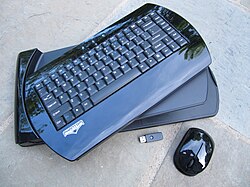HardOCP lawsuit
In September 2003 HardOCP, a computer-hardware news website, published an investigative report by writer Steve Lynch critical of Infinium Labs and its founder. [38] On February 19, 2004, Infinium Labs' lawyers sent a cease and desist letter to HardOCP's editor demanding that the news site take down the article, claiming that it "painted a portrait of a company intent on swindling the public" and threatening to file a defamation suit. Rather than concede to Infinium's demands, HardOCP owner Kyle Bennett filed a lawsuit for a declaratory judgment that his company had done nothing wrong. [39] Infinium Labs then filed suit in Florida, denying that Texas was the proper jurisdiction (although it had previously maintained a staffed office in Richardson). [40]
In September 2004, the judge required Infinium Labs to produce a number of financial records, including Roberts's personal income-tax returns, by the end of that month. Because the company failed to produce the required documents, HardOCP won a court order compelling them to do so. The judge ruled that sanctions would be awarded to KB Networks and Kyle Bennett in an amount to be determined by the court (later reported as $50,000). [41] Infinium Labs settled the suit, agreeing to drop the pending Florida suit, and admitting all allegations of KB Networks' Texas complaint; they paid $50,000 to end the suit.
Other controversies
In October 2005, it was reported that the U.S. Securities and Exchange Commission (SEC) had notified Tim Roberts that charges were pending against him for violating federal securities laws. [42] In a statement about the notice, Infinium said it was not notified of specific charges, but suspected they were related to an SEC investigation of the unlawful promotion of penny stocks (including Infinium's). [43] Roberts hired a stock promoter to send faxes claiming that the Phantom console's release was imminent, and the company's stock price might increase as much as 3,000 percent. The SEC alleged that the company never intended to release the console at the promised time due to significant unresolved "technological and manufacturing hurdles", and the faxes were part of a pump and dump scheme on the part of Roberts. Roberts reached a settlement with the SEC in which he was barred from serving as an officer or public director of a public company or participating in penny-stock offerings for five years and paid a $30,000 fine. [44] Roberts was again convicted of fraud in 2017 in a case involving his cloud commerce startup venture Savtira, which collapsed in 2011. He was sentenced to six years and eight months in federal prison, and was ordered to pay $5,874,912.52 in restitution to the victims. [45] [46] [47]
When Roberts was CEO of Infinium, the company failed to report a substantial amount of interest and penalties on unpaid payroll taxes. [48] From its inception, the company had consistently reported a small amount of cash on hand amid extensive (and increasing) debt.
In January 2006, Infinium Labs reached an agreement to borrow up to $5,000,000 from Golden Gate Investors to finance the manufacturing of the Phantom Lapboard, scheduled for release later that year. This would have been the largest amount of money Infinium Labs had ever borrowed at one time. The loan would have been repaid over three years, with an option of repayment with shares of common stock. [49]
In February, GameSpot reported that Phantom Entertainment was suspending the Phantom Game Service to develop the Lapboard. An SEC filing showed three-year losses in excess of $62.7 million, over half of which was marketing for the company and unreleased products. Over $24 million was spent on salaries and consultants, and $2.5 million on development. Infinium claimed it still intended to release the Lapboard if its financial situation improved, [50] but it missed release dates for the second quarter of 2006, October 2006 and November 2006. On August 15, 2006, Phantom Entertainment removed all references to the Phantom Game Receiver from its website, claiming that the content-delivery system targeted for the Phantom would be available for PCs running the Microsoft Windows XP Media Center edition; [51] it later indicated this service would be available in March 2007, after the initially planned November 2006 release of the Lapboard, [52] the service did not materialize when the Lapboard ultimately launched in 2008.



